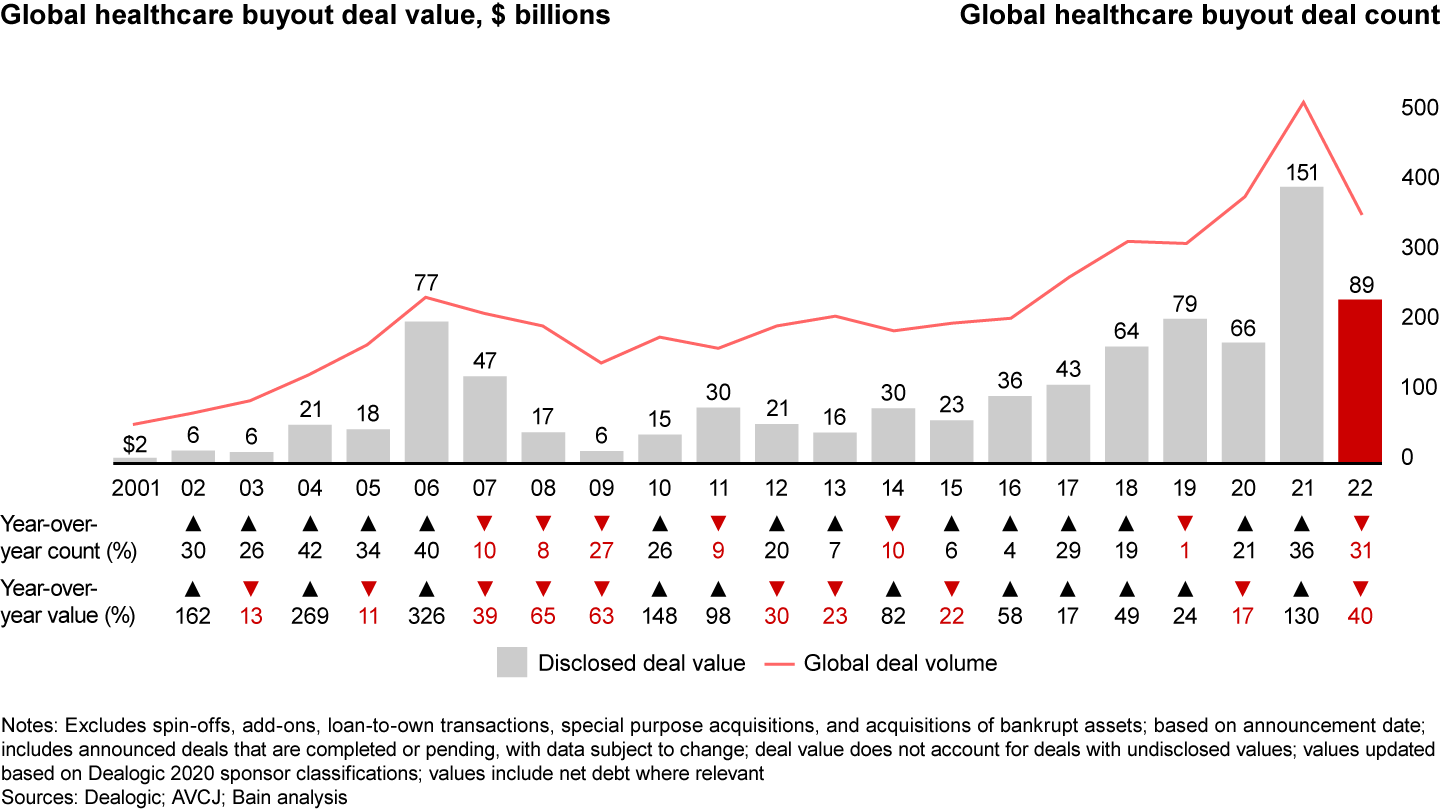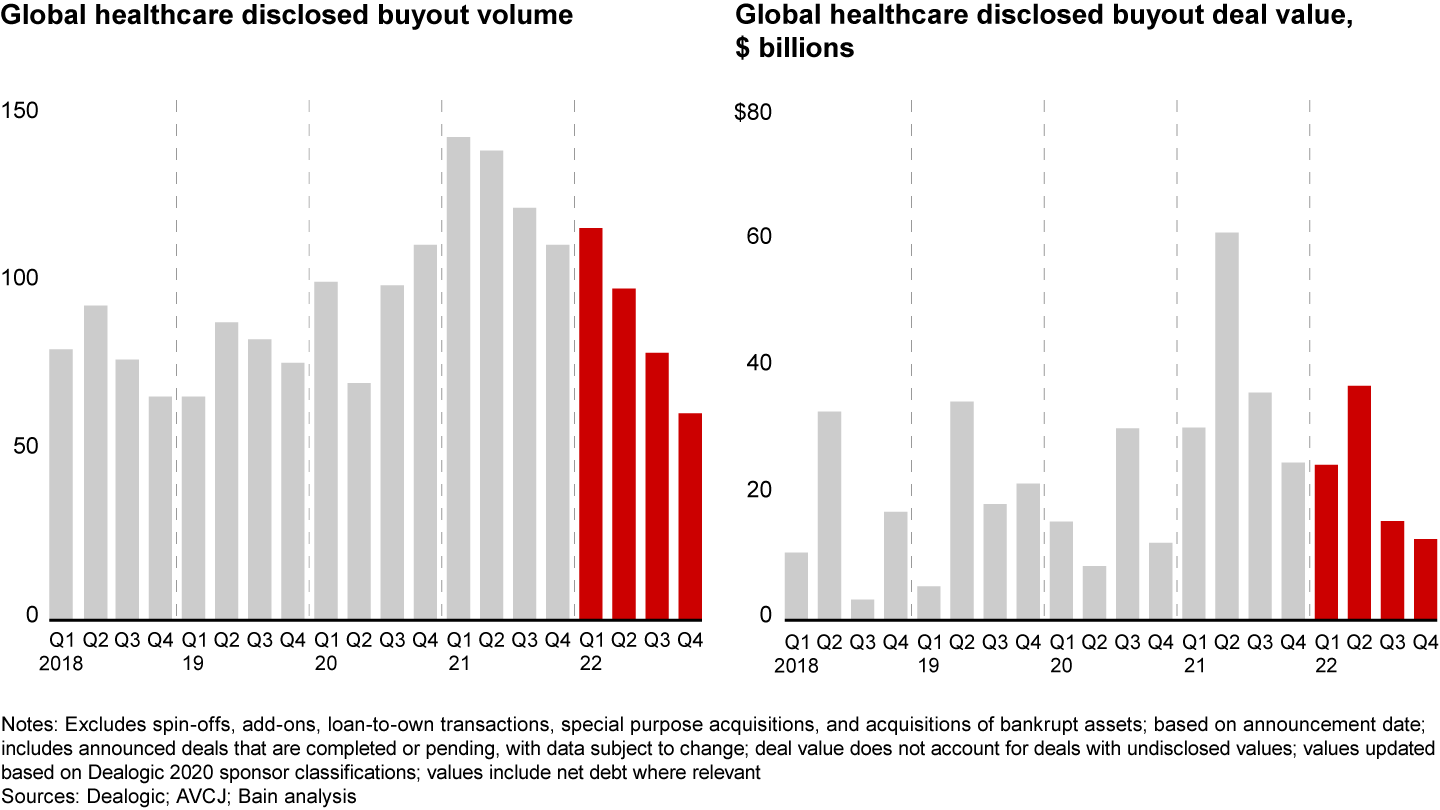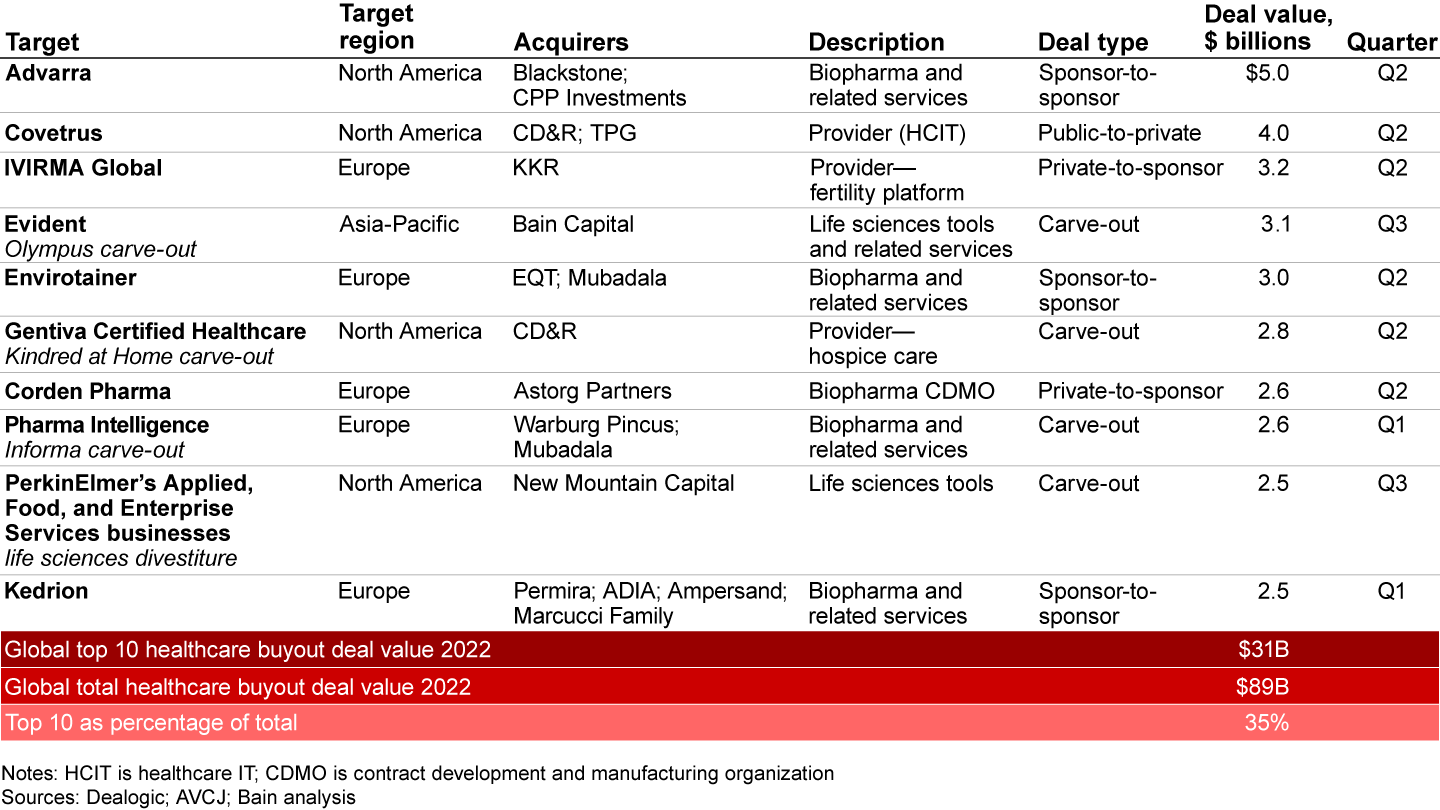Global Healthcare Private Equity Report
 }
}
At a Glance
- Down but not out: 2022 was the second-biggest year on record for healthcare private equity by many measures, even though overall activity declined sharply from 2021’s record-breaking highs.
- Tale of two halves: The first half of 2022 saw a continuation of 2021’s record-setting pace for healthcare private equity deal volume and deal value, but geopolitical uncertainty, inflation, tight credit, and labor force pressures caught up to the market in the second half.
- Narrowing focus: Funds shifted focus to find pockets of opportunity in certain subsectors and geographies. Interest in life sciences intensified, appeal of carve-outs and public-to-private deals increased, and attraction to Asia-Pacific’s maturing healthcare space was punctuated by five buyouts valued over $1 billion in the second half.
- Resilient outlook: Healthcare private equity investors face intense competition, rising US interest rates, higher labor costs, and tight credit—but ample dry powder and a track record of returns ensure healthcare will remain a priority for top firms even if winning deals requires becoming more specialized and creative in their approach.
This article is part of Bain's 2023 Global Healthcare Private Equity and M&A Report.
Healthcare private equity (HCPE) activity remained strong in the face of rising geopolitical tensions, high inflation, slumping stock markets, and spiking interest rates. Indeed, 2022 was the second-highest year on record for healthcare private equity in terms of disclosed deal value. The number of deals fell about 30% from 2021’s all-time high of 515 deals to around 350 deals in 2022, roughly in line with 2020 (see Figure 1).


Deal flow in the first quarter of 2022 maintained the record-setting pace of 2021, and a strong first-quarter pipeline led to a strong second quarter for total disclosed value. That said, geopolitical uncertainty due to the Russian invasion of Ukraine in concert with global inflationary pressures changed the trajectory for the year. Global HCPE deal volume fell in each successive quarter of 2022 and reached its lowest quarterly level since the fourth quarter of 2017. Funds that had been slammed with deal flow in 2021 felt a marked slowdown from prior quarters (see Figure 2).


Even with the global uncertainty that began early in the year, there were still some impressive exits, with more than 40 exits valued above $500 million for 2022. The year ended up with many strong showings for HCPE exits despite the slowdown from the record pace set in 2021. This demonstrates that investors are still willing to lean into compelling macro themes with strong platform assets. Notable exits include the following:
- Warburg Pincus exited its investment in primary, specialty, and urgent care provider Summit Health-CityMD through an $8.9 billion sale to VillageMD with support from Walgreens Boots Alliance (WBA) and an affiliate of Evernorth, a subsidiary of Cigna Corporation.
- Nordic Capital exited its investment in British specialty diagnostics firm The Binding Site in a deal with Thermo Fisher Scientific, valued at around $2.6 billion.
Narrowing focus: Activity shifted to more resilient investments
Beginning in the second quarter, funds started to become more selective, seeking pockets of opportunity in choice sectors, subsectors, and geographies. Funds looked for businesses resilient to a potential inflation-driven downturn or ways to take advantage of falling public valuations. Ultimately, large deal activity slowed down by the third quarter: Eight of the top 10 deals in 2022 occurred in the first half (see Figure 3).


From a healthcare subsector perspective, life sciences continued to attract interest from buyout funds, and we have seen a shift in activity toward healthcare information technology (HCIT). Investors see long-term HCIT opportunity around redefining care delivery and accelerating clinical breakthroughs, and in 2022, there was particular interest in buyouts for businesses that will help optimize operations, especially given the possibility of a recession.
Seven of the top 10 deals were in biopharma, life sciences tools, and related services, demonstrating that PE funds found ways to mitigate the binary pipeline risk of biopharma assets, often by investing in organizations that provide products or services to a broad set of industry participants.
From a geographical perspective, activity slowed overall, but the Asia-Pacific region saw a strong interest in large deals, with six deals valued over $1 billion—five of them transacted in the second half of the year—reflecting the growing maturity of the market. Deals valued at more than $1 billion in Asia-Pacific in 2022 included Evident, CitiusTech, and iNova Pharmaceuticals.
Healthcare technology and technology-enabled businesses continued to be a very active sector, with investment themes focused on honing clinical, operational, and financial workflows as well as data plays across stakeholders.
- Workflow management: On payer workflow, TPG closed a $2.2 billion deal for Change Healthcare’s claims-editing business, ClaimsXten. Bain Capital acquired LeanTaaS, which provides software solutions for optimizing operations and capacity management.
- Remote/home care: General Atlantic and CVS led a $300 million Series D investment in Biofourmis, a virtual care and digital medicine-focused HCIT company.
- Revenue cycle: Veritas Capital merged two revenue-cycle management (RCM) companies—Coronis Health and MiraMed Global Services—to create a multispecialty RCM platform.
- Clinical data: THL acquired a majority stake in Intelligent Medical Objects, an HCIT data enablement company that brings quality clinical data to a range of use cases to inform better patient care, including clinical documentation and population health management.
- Life sciences data: Norstella—which is backed by Hg Capital, Welsh, Carson, Anderson & Stowe, and Warburg Pincus—added Citeline (formerly Pharma Intelligence) to its pharmaceutical technology platform via merger. At deal close, the $5 billion company is one of the largest pharma intelligence solution providers, spanning five brands that make up Norstella: Evaluate, MMIT, Panalgo, The Dedham Group, and now Citeline.
Abrupt changes in central bank monetary policy to fight inflation in North America and Europe led to a tight credit market that limited large-check financing. Anecdotally, funds suggested that traditional credit financing above $1 billion was largely unavailable in the second half of 2022, which may delay potential megadeal activity into 2023 or beyond. Available credit has come at much higher interest rates than the past few years, which led funds to take different approaches to financing to get deals done.
- All-equity deals: Funds have signaled an interest in pursuing all-equity buyouts that they may recapitalize when the public credit market improves.
- Club deals: We are seeing a continuation of club deals. In 2021, funds pooled together on large assets like Medline and Athena, and in 2022 the motivation shifted to solve for funding availability. For example, GHO Capital Partners and Vistria Group joined hands to acquire Alcami, a biopharma contract development and manufacturing organization (CDMO).
- Private credit: Firms like Owl Rock Capital, Ares Management, and BlackRock were willing to step in and provide large-debt financing via private debt, with Owl Rock suggesting they had the most requests for checks over $1 billion in their history. Carlyle Group is in talks to acquire Cotiviti for $15 billion, and financing reportedly includes a $5.5 billion private loan.
As credit availability tightened, the average buyout deal size fell globally in the second half of 2022, most severely in Europe. Private equity sponsors are also shifting focus to mergers and acquisitions within their existing portfolios, for example, through healthcare IT tuck-ins and physician practice management roll-ups, especially in emerging specialties and midcap biopharma platform building.
Range of outcomes for 2023
There is likely to be a range of potential outcomes for healthcare private equity in 2023. See our “Healthcare Private Equity Outlook: 2023 and Beyond” for a discussion of potential scenarios and open questions facing the HCPE market in 2023.
Some signals continue to point to a global economic slowdown in 2023. In this scenario, funds may consider updating their downturn playbook based on the section “Healthcare Private Equity in a Downturn.” On the flip side, in the face of uncertainty in 2023, funds that lean into new sectors may be rewarded. “Life Sciences: White-Hot Competition to Win the Right Deals” offers a view on the challenges involved with investing in biopharma and life sciences tools and highlights success stories from those subsectors.